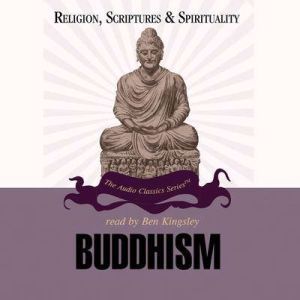
List: $11.95
| Sale: $8.36
Club: $5.97
Buddhism
Author: Dr. Winston King
Narrator: Ben Kingsley
Unabridged: 2 hr 59 min
Format: Digital Audiobook Download
Publisher: Knowledge Products, Inc.
Published: 04/26/2006
Category: Religion
Synopsis
Siddhartha Gotama, The Great Wayshower, lived in the sixth century BCE in the Hindu culture of an area near modern Nepal. After six years as a Hindu ascetic, Siddhartha renounced asceticism after discovering that clearmindfulness, not the pain of ascetic practice, is the key to spiritual understanding. He sought a new kind of awareness characterized by mastery over all emotions a sharp, clear awareness that is unswayed by selfinterest. The term Buddha came to refer to one who has relinquished all clinging to concerns related to space and time, thus transcending individualized existence. Buddhisms Path to Enlightenment has three aspects: Sila (morality), Samadhi (concentrated meditation), & Panna (liberating insight). Nirvana is the highest good and the ultimate goal: the key to Nirvana is within oneself, not in ritual. Karma is the accumulated sum of ones deeds: fate is the result of these deeds throughout former lives, so each person always deserves what occurs. About two centuries after Gotama Buddhas death in the early fifth century BCE, King Ashoka converted to Buddhism, thus solidly establishing this religion in India. However, by the ninth century CE (over 1,000 years later), Buddhism had disappeared in India, giving way to Hindu bhakti movements, Jainism, & Islam. Theravada (teaching of the elders) Buddhism, the most traditional form of Buddhism, migrated to Southeast Asia (what is now Burma, Thailand, and nearby countries). Mahayana (great and grand way) Buddhism expanded the role of the nonmonk and migrated to Central Asia, Tibet, and China, though this process had begun as early as the first century CE. In China, Buddhism took two main forms: Pure Land (or Western Paradise) Buddhism, and Taoistinfluenced Chan, later known as Zen in Japan. Entering Japan in the sixth century from Korea, Buddhism coopted the Shinto deities (known as kami). Within Japan, Buddhism splintered into many varieties such as Shingon (True Word), Tendai (Original Enlightenment), as well as Pure Land, Zen, and Nichiren Buddhism. In the twentieth century, Japanese Buddhism, especially Zen would export its ideas to the western world. Many people have been attracted by Buddhisms nondoctrinal and existential emphasis on meditation, insight and the search for the beyond that is within.